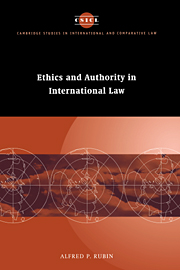Book contents
- Frontmatter
- Contents
- Preface
- Acknowledgments
- List of abbreviations
- Table of cases
- Table of statutes
- Table of treaties
- 1 Introduction
- 2 The international legal order
- 3 Theory and practice come together
- 4 Putting it together
- 5 Implications for today
- Bibliography
- Index
- CAMBRIDGE STUDIES IN INTERNATIONAL AND COMPARATIVE LAW
3 - Theory and practice come together
Published online by Cambridge University Press: 14 September 2009
- Frontmatter
- Contents
- Preface
- Acknowledgments
- List of abbreviations
- Table of cases
- Table of statutes
- Table of treaties
- 1 Introduction
- 2 The international legal order
- 3 Theory and practice come together
- 4 Putting it together
- 5 Implications for today
- Bibliography
- Index
- CAMBRIDGE STUDIES IN INTERNATIONAL AND COMPARATIVE LAW
Summary
The United States of America
As in many newly independent countries, the elite that found itself responsible for governing the thirteen British colonies during their war of independence first attempted to preserve their separate political bases by maintaining the separate legal existence of those colonies, now become states in the international legal order. The Articles of Confederation were agreed in a Congress of the separate states' representatives on 15 November 1777. They take the form of an alliance in which “Each State retains its sovereignty, freedom, and independence, and every power, jurisdiction and right, which is not by this Confederation expressly delegated to the United States in Congress assembled.”
To satisfy the jus inter gentes under which an alliance with France was envisaged, the Articles of Confederation were construed almost immediately to give the thirteen colonies, as “states,” a single legal personality with which to face the world. Despite the laggardly ratification by Maryland, which was not produced until 1 March 1781, two treaties in the name of the “Thirteen United States of North America” (listed in the preambles of each to include Maryland) were concluded with France and signed at Paris on 6 February 1778, ratified by the Congress on 4 May 1778.
But the laws of war as they applied to real persons and property fell into the domain of the jus gentium by the concepts of Blackstone's contemporaries; they were conceived as the reason-based uniform law of all civilized countries enforced in disputes among private parties by the municipal courts of all countries.
- Type
- Chapter
- Information
- Ethics and Authority in International Law , pp. 70 - 137Publisher: Cambridge University PressPrint publication year: 1997
- 1
- Cited by

